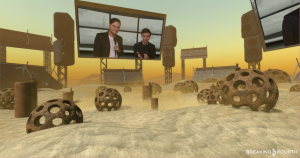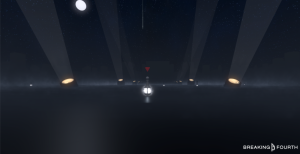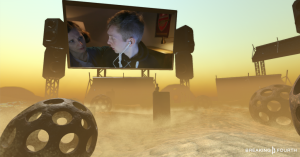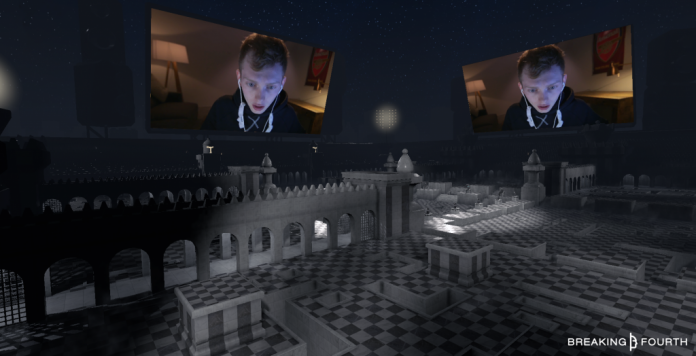This week has seen the launch of Breaking Fourth’s virtual reality (VR) drama, Ctrl, but its release isn’t like other either understated or tech-heavy VR demonstrations. Breaking Fourth has created a real event that knocks down the barriers that set VR enthusiasts and the average person apart.
Ctrl itself is a drama that centers around a teenage boy called Liam who is competing in the finals of a videogame contest, something that resembles Chess but with a modern twist, in order to win a large sum of cash. What happens beyond that, however, is what really adds weight and substance to the forewarned emotional piece. The experience that the audience gets while watching Ctrl is comprised of coming to new realisations throughout the piece, going from an energy-filled start to a pretty heart-numbing conclusion.
It can’t be denied that Ctrl is a thought-provoking experience that leaves a deep impression. But, the premiere Breaking Fourth has put together this week for it has knocked the ball right out of the park, pushing VR well outside the realm of experimental into what felt like the mainstream.
When taken down to the room where the it all kicks off, passing signs that give warnings to the nature of the piece, each of the audience members can choose a swivel seat where there is a Gear VR placed on it, along with headphones already plugged in. We are not asked to put it on yet, which gives a chance for us all to look around and talk to one another, sharing our expectations.
The show, as that is what the whole premiere essentially is, starts off with Dominic, or ‘Dom The Dominator’, pitured below, who features in the short film as one of the presenters of the videogame competition that Liam is partaking in. Dom’s character spills out before us in an engaging and energy-pumped performance, with smiles filling the room.

Founder & CEO of Breaking Fourth, David Kaskel, told of me what he wanted when planning the premiere: “I wanted to do something that combined film and gaming, which I see as the two mains that narrative VR will be drawing from. But also, I’m particularly interested in theatre, which is why we brought in playwrites and theatre actors, because I think ultimately the medium is about presence, the stage you create, and how you understand where you are, and that’s a theatrical experience.
“We were considering how do we show this, and there aren’t that many headsets out there, and we wanted people to see it who weren’t particularly thinking “I’m going to go and get a VR headset”. We wanted to draw on people who liked media, who liked theatre, to come in – and that’s why we chose Rada, it is very famous for its theatre. We wanted it to feel like it was theatrical and it was all part of the piece, and we spoke to Oliver [Dom] and convinced him to be part of it. We thought, okay this will work well to bring the whole thing together so it feels like it makes sense. I didn’t want it to feel like a tech demonstration.”
And that is exactly why this was like nothing that I had experienced before: it’s not just another tech demo. There wasn’t talk about the Gear VR and how amazing it will make the experience. It was an accessory to the overall show, and that is true mainstream adoption of VR.

Dom had only explained how to adjust the straps and put on the Gear VR, and that is all that the audience wanted to know, especially with the diversity of the audience: young and old, men and women, tech and theatre lovers.
Kaskel explained that Breaking Fourth had designed their own system of streaming the film on all of the headsets without the users needing to press a single button.
“So we developed that technology, but every time it starts I’m always worried it’s not going to work but so far it has been working great! We wanted everyone to see it at exactly the same time. We had done, early in the test marketing of it, a few times where we brought in three or four people and we had them press play at the same time.”
“There was one time where there were two boys that must have been nearly 16,” Kaskel started to explain, recounting a time when synchronised streaming of the film created a greater theatrical impact. “They took it off and they just stared at each other for 20 seconds, and one of them just said “Jesus”. Then we knew at that moment that everyone coming out of the same place at once is the essence of theatre.”

And when we all took off our headsets, I can’t say our experience was much different, apart from the atmospheric smoke filling the floor, and the party starting Dom now sombre and looking towards the ground. We exited the room quietly, blown away by the entire performance.
It can be assured, and thankfully so, that this won’t be a one of a kind event. Breaking Fourth is working to create more dramatic and theatrical pieces with a similar impact to what Ctrl gives – around 10 more, to be exact. I can only hope that Breaking Fourth becomes the standard of VR theatre in not only the capital, but the whole world.















